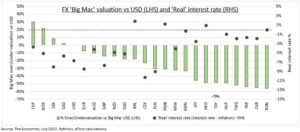BURGERNOMICS: The Big Mac index is a useful shorthand for currency valuation, with a good track record. Latest numbers (see chart) show only four big currencies pricier than the US dollar after its recent surge. This could be a USD reality check with global risk-aversion now fading and nearing a Christmas Fed interest rate peak. Data also highlights the large 8% average Big Mac price increase in only six months, and the relative attraction of emerging market currencies.
RISING PRICES: Big Macs are also a global measure of inflation. Local burger prices are up a big 8% on average globally in just the past six months. This ranges from a 2% price cut in China to a 14% increase in Czech and 18% in Poland. McDonald’s (MCD) ended its US Dollar Menu in 2013 but its £0.99 cheeseburger lasted 14 years in UK until its 20% increase at the end of July.
REAL SUPPORT: Real interest rates (interest rates – inflation) are an important FX anchor. Only 3 have positive real rates (BRL, HKD, RMB) and this has helped them this year. Turkey (TRY) has been the opposite. Emerging market currencies have cheaper valuations and higher real rates than developed markets. Thus room for stronger currencies, or rate cuts, as inflation falls.
THE INDEX: It was created by The Economist in 1986 as a light-hearted way to compare currency valuations. The theory (Purchasing Power Parity) is that exchange rates should equalize in the long run, so that similar goods have similar prices. It has spawned spin-offs for similar globally available standardized products, from a tall latte (Starbucks) to iPhone (Apple).

All data, figures & charts are valid as of 08/08/2022



